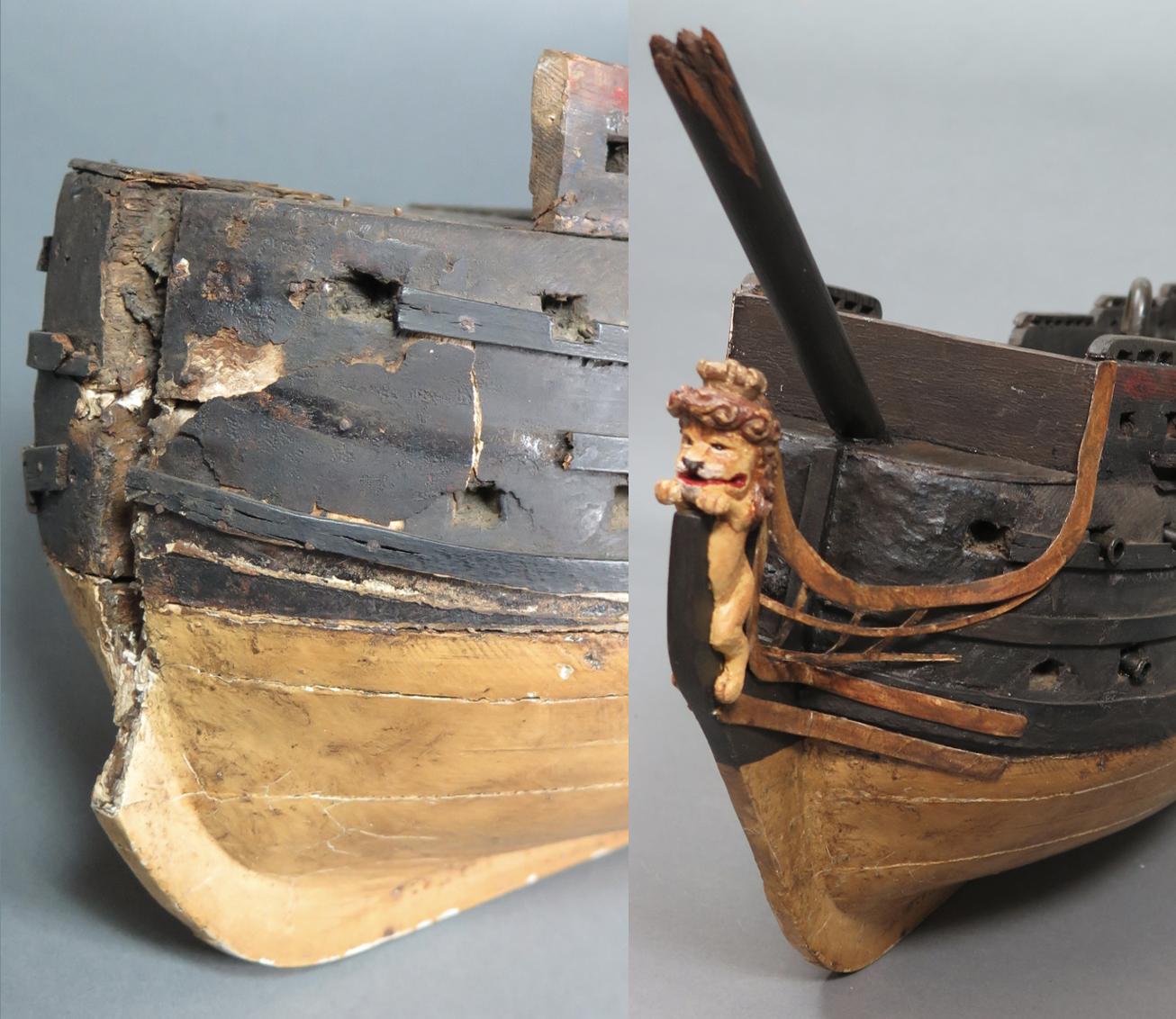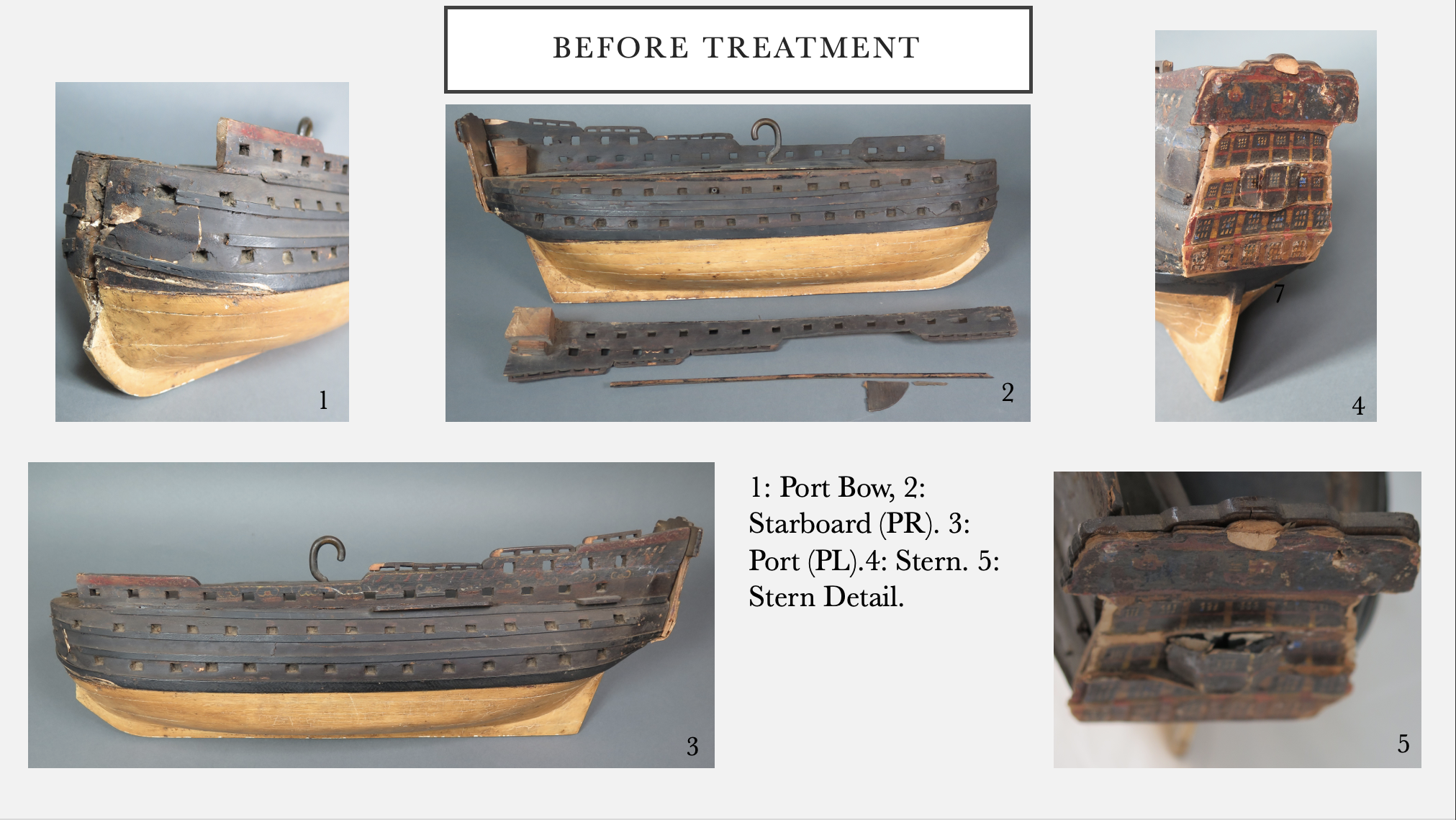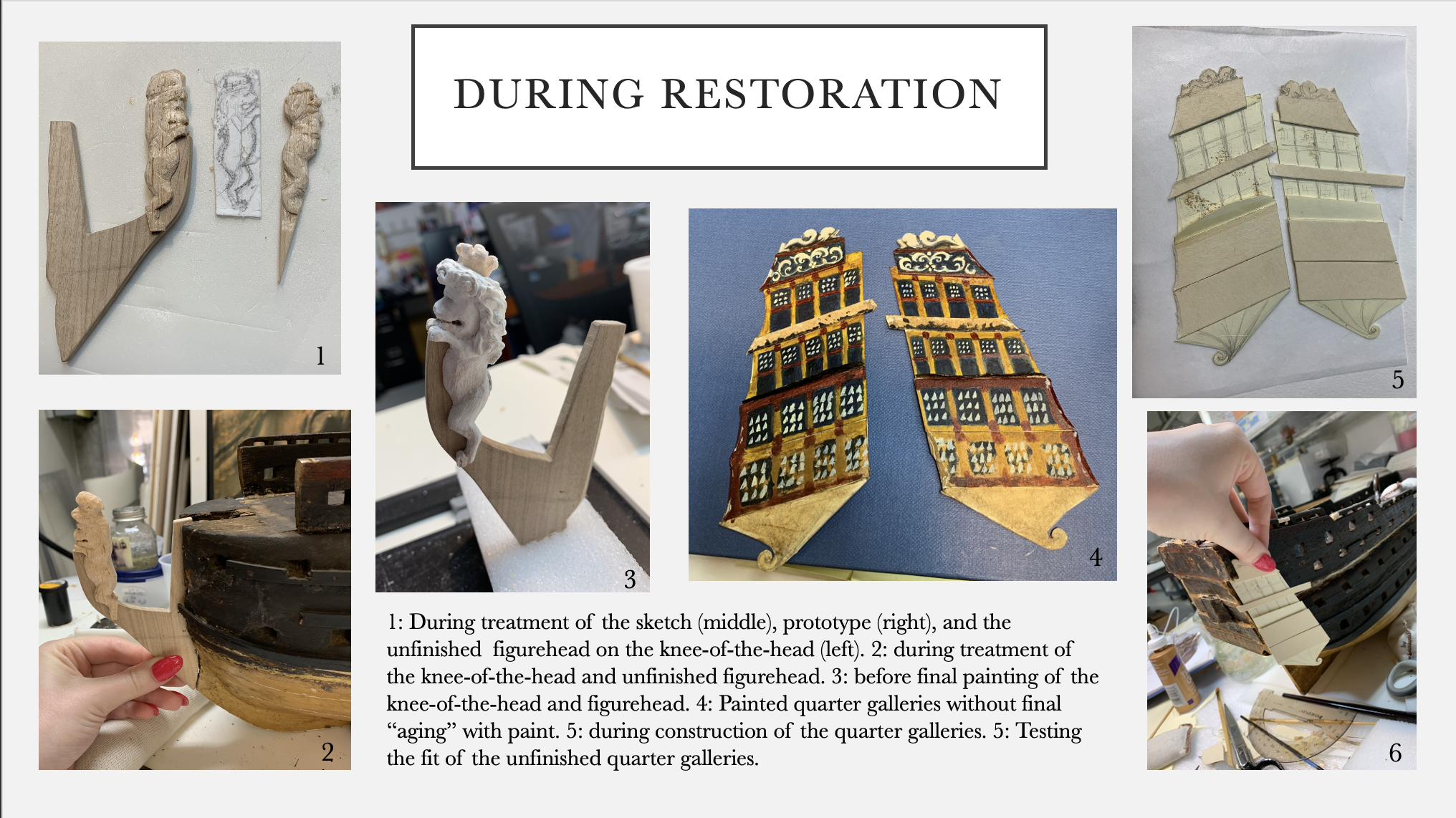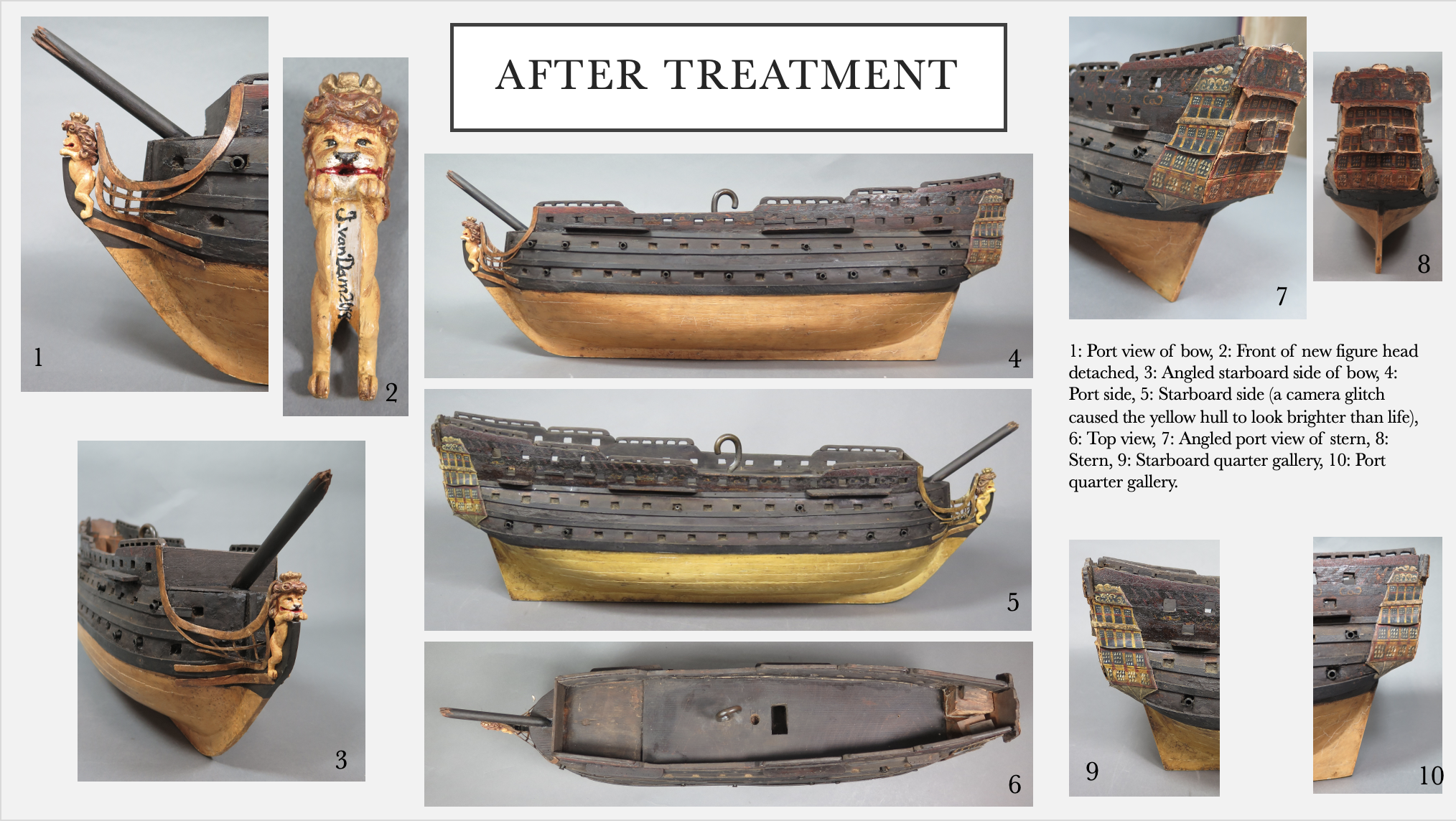
Votive Ship Model



Description
A block type (hull is formed of a single block of wood) votive ship model from the early 1700’s. This type of ship model likely would have hung in a church in a coastal area. The exact origin of this model is unknown although it is likely from Europe or the United Kingdom. It features a stern which is decorated in paper with a heraldic crest and a small balcony. Painted decorations on the exterior sides of the decks are in red, blue and yellow.
Condition
Overall
•The surface of the entire object is dusty with centuries of accumulated grime and use wear with insect frass in some small crevices.
Hull
•The hull of the ship is mostly intact. The interior is solid wood and seems to be in good condition where it is visible.
•There is an outer plaster- like coating on the upper part of the hull, what would be above the water line (painted black in this case), which is cracked and separating from the underlying wood in some places. The most notable place is near the bow on the port side where a large piece has become completely detached and is held only with a wire nail which has rusted.
•Decorative wood bands have become detached from the starboard side beneath the side rails. On the portside, there are 3 small pieces missing from the 3 lowest decorative bands on the bow.
•The gunports are dusty.
•Beneath the waterline (painted yellow in this case) the surface is cracking where there are underlying boards but seems mostly solid.
Cannons
•Only one original cannon remains, it is on the starboard side near the center of the ship on the second gunport deck and likely made of some type of cast metal, though no tests to determine its exact composition were conducted
Stern
•The stern is constructed with a piece of wooden plyboard for support and shape, then is decorated with varying thicknesses of paper which create a semi three-dimensional surface. The paper is held in place to the rest of the ship with failing glue and some nails. The paper is painted to indicate windows and a heraldic crest and other decorative features. Some of the paper has come off or is wearing off as well as some of the paint. The surface was coated in a varnish at some point that has discoloured, darkening the whole surface. The underlying board is fairly secure but there are small gaps near the top where it connects to the sides of the ship, likely due to age and warping .
Bow
•The bow is very damaged and is missing the entire front piece (knee of the head, head rails and figure head). There is a space where it is clear this section of the ship once existed but has been knocked out or broken off. The surrounding area is cracking with a lot of loose material, including plaster, wood and paint. There are also some spare nails currently holding nothing in place.
•The deck is largely intact, the middle section is a large piece of plywood, with the indentations to indicate boards carved into the surface. This section is lifting from the underlying wood surface due to failing glue. In the near centre of the ship and deck is a rectangular hole (purpose unknown), a centre hole, possibly for a mast and a brass hook from which the ship would have hung. There is a large square of deck missing from near the bow, and then two pieces of deck right at the front of the bow, the port side has become detached. The deck stops right before the stern where the deck rails attach to the deck.
Treatment
•Surface was brushed and vacuumed, and the gun holes were cleaned using saliva and cotton swabs.
•Starboard rails and “decks” cleaned of old glue using laponite and a scalpel, then reattached using Paraloid B72 20% in acetone and any gaps filled with Paraloid B72 20% in acetone and microballoons. The top section of the broken off rail unit was cracked and repaired with nails, these nails were removed, and the sections were reattached using fish glue, then Paraloid B72 20% in acetone and microballoons were used to fill any gaps.
•Cracks in the hull were filled using Paraloid B72 20% in acetone and microballoons with coloured pigments
•The gaps left between the stern and the deck rails were filled with pieces of balsa wood adhered with Paraloid B72 20% in acetone and inpainted using acrylic paint.
•Stabilization of the paint on the stern paper using Aquasol 7% in acetone.
Restoration
All restoration work was done at the request of the curator, who hoped a more complete vessel would be more impactful for museum visitors.
Missing rails were constructed by plying balsa wood pieces together with Paraloid B72 20% in acetone then carving the resulting block. These pieces were then painted to match using acrylic paint and adhered with Paraloid B72 20% in acetone. The forward and mid rails on the port side were replaced as well as the back half of the aft rail on the port side.
The missing forward port channel was constructed form balsa wood and painted with acrylic paint to match the other channels, then adhered using Paraloid B72 20% in acetone. Loose channels were reattached using Paraloid B72 20% in acetone.
A new knee of the head was cut from a piece of ¼ inch thick maple wood and attached to the bow using Paraloid B72 20% in acetone, and the remaining space filled and shaped with Paraloid B72 20% in acetone and Microballoons. The shape of the knee of the head was based off a 60-gun ship from 1720 per the suggestion of the curator. A piece of balsa wood was added between the two forward rails to indicated the forward section of the forecastle. This also helped with stability of the forward rails and made the bow of the ship look complete.
A figure head was carved from a balsa wood block which was made to fit around the knee of the head. The balsa was reinforced using 5% methyl cellulose in a 50/50 isopropyl alcohol and distilled water solution. Then it was carved and details were added using spackle and then it was painted. The figure was that of a lion which were often used on unnamed ships. The figurehead is secured only by friction so that it can be removed safely. It is signed by the artist “J.van Dam 2019.”
Head rails were created using different thicknesses of paper and attached to the ship using Paraloid B72 20% in acetone, then painted a dark yellow orange using acrylic paint.
A new bowsprit was constructed using a wooden dowel which was carved to look like it had been broken off. It was then painted to match the whole model’s aesthetic. It was attached where there was a hole in the deck, likely where there was once a bowsprit, using Paraloid B72 20% in acetone and bulked using glass microballoons. The end in the deck was then secured with a small piece of Japanese paper and methyl cellulose for added security. When deciding the steeve or angle of the bowsprit, Rob Napier, a full and half-hull model ship expert and conservator was consulted.
New cannons were constructed using paper straws cut into 1cm pieces with black string wrapped and attached to one end using Paraloid B72 20% in acetone, then the whole surface painted black. Several of these new cannons were distributed at random so the ship might appear slightly wrecked, a look compounded by the ‘broken’ bowsprit.
New quarter galleries were constructed out of layers of different thickness of archival paper and tacky craft glue in an attempt to match the stern decorations. These were then fully painted, then sanded to imitate age, varnished using a yellow tinted water based varnish, then dusted using a bulking agent to imitate the accumulated dust on the rest of the ship, and finally the surface was aged using acrylic paint. These were then adhered to a thin piece of archival paper using the tacky craft glue and adhered to the ship using Paraloid B72 20% in acetone.
While the quarter galleries are brighter in colour compared to the original stern decorations it seemed important to keep minor differences so that it was clear this was a restored model and not all of it was original which helps maintain the piece’s authenticity. This is also true of the new knee of the head, head rails, bowsprit and figurehead as well.
When complete Rob Napier was again consulted to asses the restoration and ensure everything added fit with the estimated date of the ship and the aesthetic of the original parts of the model.